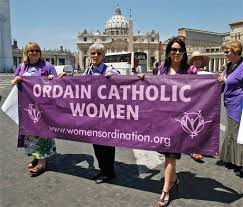APPEAL TO POPE FRANCIS TO REINSTATE WOMEN’S DIACONATE (Part I)

Feasts of St Phoebe and St Gregory the Great, 3 September 2015
Wijngaards Institute,111a High Street, Rickmansworth , Herts – WD3 1AN,UK.
 (Note: Fr.John Wijngaards, originally from Holland has been a great missionary in the 1960ies in Andhra Pradesh. He was at the same time a professor at St.John’s Seminary, AP, a well known theologian championing the cause of Women’s ordination as well. He worked with New Leader of Chennai to bring out Andhra edition of NL edited then by james kottoor..He had to return to Holland at the call of his superiors. He was one of the organizers of the First Women’s Ordination world wide in the Catholic Church in Dublin in 2001. Now he is stationed in UK at the above address, running Wijingaards Institute of Catholic Research, at the above address. On Sept.3rd feasts of S.Phoebe and St.Gregory the Great, his institute has sent the letter below to Pope Farncis to promote the cause of women to Diaconate. james kottoor, editor)
(Note: Fr.John Wijngaards, originally from Holland has been a great missionary in the 1960ies in Andhra Pradesh. He was at the same time a professor at St.John’s Seminary, AP, a well known theologian championing the cause of Women’s ordination as well. He worked with New Leader of Chennai to bring out Andhra edition of NL edited then by james kottoor..He had to return to Holland at the call of his superiors. He was one of the organizers of the First Women’s Ordination world wide in the Catholic Church in Dublin in 2001. Now he is stationed in UK at the above address, running Wijingaards Institute of Catholic Research, at the above address. On Sept.3rd feasts of S.Phoebe and St.Gregory the Great, his institute has sent the letter below to Pope Farncis to promote the cause of women to Diaconate. james kottoor, editor)
Dear Pope Francis,
Respectfully we ask you to restore to women the diaconal office in our Roman Catholic Church. How better may we embrace the Spirit and respond to the signs of the times than by giving such freedom and dignity to women, for the good of all, in equality and fraternity?
Contemporary research shows that tens of thousands of women served as ordained deacons during the first millennium of the Church: in Italy, Gaul, Greece, Asia Minor, Palestine and Egypt. That they received a full diaconate ordination is clear, a ‘sacramental’ ordination in today’s theological language. Here is a prayer of 780 AD:
Holy and Omnipotent Lord,
through the birth of your Only Son our God from a Virgin according to the flesh, you have sanctified the female sex. You grant not only to men, but also to women the grace and coming of the Holy Spirit.
Please, Lord, look on this your maidservant and dedicate her to the task of your diaconate, and pour out into her the rich and abundant giving of your Holy Spirit. Codex Barberini Gr.336
Many documents confirm that these ordinations were by the imposition of the bishop’s hands and took place in the sanctuary, in front of the altar and during the Eucharistic Liturgy immediately after the Anaphora, just like for the ordination of male deacons, presbyters, and bishops. Several of your predecessors authorised Sacramentaries containing ordination prayers for women deacons.
There should be no room in our Roman Catholic Church today for the rationale which subverted female deacons in the Middle Ages: the phobia concerning menstruation and the conceit that women are innately inferior to men. The need for the ministry of women deacons is plain in every country. May your hands be the first to restore the diaconal dignity to women.
With respect and love,
the Trustees, Patrons and Staff of the Wijngaards Institute
Documentation
Social and cultural changes are giving women in our time the opportunity to play vital roles in so many areas of life. This also affects Christian communities all over the world. There is an urgent need for the Roman Catholic Church to recognise the important pastoral ministries already exercised by women, and to invite others to take up similar responsibilities.
For the Roman Catholic Church to meet this challenge adequately, we urgently request you to reinstate the diaconal ministry of women that existed during the Church’s first millennium.
Women’s diaconate in the past
For almost a thousand years women deacons prepared female catechumens for baptism. They anointed them during the baptismal ceremony itself.1 They assisted female members of the congregation during church services. They visited the sick and took them the Viaticum.2 They anointed the dying and arranged the deceased for their funeral. In the absence of a male deacon, they assisted the presbyter at the altar when celebrating the Eucharist.3
Research has shown that tens of thousands of women served as fully ordained deacons in local churches during ten long centuries. Some of them ministered in Italy4 and Gaul5, but the vast majority lived and worked in Greece6, Asia Minor7, Syria8, Palestine and Egypt9, remembering that these latter were Eastern regions of the Christian Church as yet undivided by the schism of 1054 AD.
The ordination rite for women deacons
The ordination of women deacons was clearly a real ordination, ‘sacramental’ to use today’s terms10 and substantially identical to the ordination of male deacons. The rite has been preserved in ancient manuscripts, such as the Barberini Gr 336 (780 AD),11 the Bessarion (1020 AD),12 Vatican Mss Gr 1872 (1100 AD),13 the Coislin Gr 213 (1050 AD)14 and the Codex Vaticanus Syr 19.15
That the rite conferred a full ordination to the diaconate, equivalent to that for male deacons, is clear from the following facts:
The female deacon, just like her male counterpart, was ordained by the Bishop who imposed hands on her while invoking the Holy Spirit: “Holy and Omnipotent Lord, through the birth of your Only Son our God from a Virgin according to the flesh, you have sanctified the female sex. You grant not only to men, but also to women the grace and coming of the Holy Spirit. Please, Lord, look on this your maid servant and dedicate her to the task of your diaconate, and pour out into her the rich and abundant giving of your Holy Spirit.”
The Bishop, while still imposing hands, spoke a second prayer of ordination, the ekphonese, characteristic only for the three major orders of episcopacy, presbyterate and diaconate. Before the ordination of both the male and female deacon the Bishop publicly declared his intention of ordaining the candidate to be a deacon in the ‘Divine Grace’ statement, as only happened for all major orders.
The ordination of both male and female deacon took place in the sanctuary before the altar, during the liturgy of the Eucharist and at a very solemn moment, namely after the sacred Anaphora. In contrast, so-called minor orders, such as the lectorate and subdiaconate, were imparted by a simple imposition of hands outside the sanctuary and not during the Eucharist.
Both the male and the female deacons received the diaconal stole, the diakonikon, as a sign of their ecclesiastical rank. During the ordination rite the bishop handed the chalice to the female deacon, just as he did for the male deacon, which indicates that deacons of both sexes had equal authority to distribute communion.17
These features convince a vast majority of scholars that the rite was truly an ordination establishing women as much as men in the major order of the diaconate.
Confirmation in Tradition
Overwhelming evidence shows that, at least in the Eastern part of the Church, women were fully accepted as ordained ministers during the first millennium. In Scripture we read about “Phoebe, our sister, who is a deacon [diakonos] of the church at Cenchreae” (Romans 16,1-2). Scholars attribute to her a true ministry.19 We find the instruction in 1 Timothy 3,8-11: “Deacons [diakonous] must be serious, reliable in what they say, not given to wine, not greedy for money […]. The women [deacons] in the same way should be respectable, not gossips, but sober and reliable in everything.” That this refers to ordained women deacons and not deacons’ wives follows from an attentive reading of the Greek text and is confirmed by the interpretation of early Greek Fathers of the Church.
To be continued
















